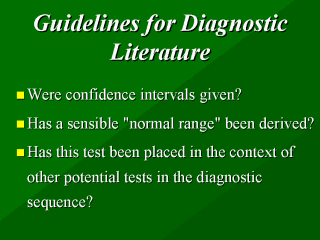| front |1 |2 |3 |4 |5 |6 |7 |8 |9 |10 |review |
 |
-
Question 8: Were confidence intervals given? (Greenhalgh, 1997) A confidence interval, which can be calculated for virtually every numerical aspect of a set of results, expresses the possible range of results within which the true value will probably lie. If the jury in the first example had found just one more murderer not guilty, the sensitivity of its verdict would have gone down from 67% to 33%, and the positive predictive value of the verdict from 33% to 20%. This enormous (and quite unacceptable) sensitivity to a single case decision is, of course, because we validated the jury's performance on only 10 cases. The larger the sample, the narrower the confidence interval, so it is particularly important to look for confidence intervals if the paper you are reading reports a study on a relatively small sample. - Question 9: Has a sensible "normal range" been derived? (Greenhalgh, 1997) If the test gives non-dichotomous (continuous) results—that is, if it gives a numerical value rather than a yes/no result—someone will have to say what values count as abnormal. Defining relative and absolute danger zones for a continuous variable (such as blood pressure) is a complex science, which should take into account the actual likelihood of the adverse outcome which the proposed treatment aims to prevent. This process is made considerably more objective by the use of likelihood ratios. - Question 10: Has this test been placed in the context of other potential tests in the diagnostic sequence? (Greenhalgh, 1997) In general, we treat high blood pressure simply on the basis of a series of resting blood pressure readings. Compare this with the sequence we use to diagnose coronary artery stenosis. Firstly, we select patients with a typical history of effort angina. Next, we usually do a resting electrocardiogram, an exercise electrocardiogram, and, in some cases, a radionuclide scan of the heart. Most patients come to a coronary angiogram only after they have produced an abnormal result on these preliminary tests. If you sent 100 ordinary people for a coronary angiogram, the test might show very different positive and negative predictive values (and even different sensitivity and specificity) than it did in the ill population on which it was originally validated. This means that the various aspects of validity of the coronary angiogram as a diagnostic test are virtually meaningless unless these figures are expressed in terms of what they contribute to the overall diagnostic work up. |
| front |1 |2 |3 |4 |5 |6 |7 |8 |9 |10 |review |